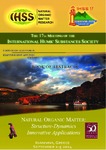Por favor, use este identificador para citar o enlazar este ítem:
http://www.alice.cnptia.embrapa.br/alice/handle/doc/1001331Registro completo de metadatos
| Campo DC | Valor | Lengua/Idioma |
|---|---|---|
| dc.contributor.author | VIANNA, M. | pt_BR |
| dc.contributor.author | NOVOTNY, E. H. | pt_BR |
| dc.contributor.author | SILVA, T. S. | pt_BR |
| dc.contributor.author | RIBEIRO, B. R. | pt_BR |
| dc.contributor.author | DITTZ, L. A. | pt_BR |
| dc.date.accessioned | 2014-12-02T11:11:11Z | pt_BR |
| dc.date.available | 2014-12-02T11:11:11Z | pt_BR |
| dc.date.created | 2014-12-02 | pt_BR |
| dc.date.issued | 2014 | pt_BR |
| dc.identifier.citation | In: MEETING OF THE INTERNATIONAL HUMIC SUBSTANCES SOCIETY, 17., 2014, Ioannina. Natural organic matter: structure-dynamics innovative applications: book of abstracts. Ioannina: University of Ioannina, 2014. p. 323-324. | pt_BR |
| dc.identifier.uri | http://www.alice.cnptia.embrapa.br/alice/handle/doc/1001331 | pt_BR |
| dc.description | The study of soil organic matter of the "Terras Pretas de Índios" showed an efficient compost model for improving the physical chemistry properties of the soil. The charred materials have the condensed aromatic structures but it does not provide carboxylic groups, that are important for its reactivity and its contribution to soil CEC. The objective of this study is to evaluate the ecotoxicity of functionalized charcoal compounds (humic acids like material - HALM) through its sub-lethal kinetic behaviour of the enzyme AChE even in the presence of pesticides. Activated charcoal was chemically oxidized using sodium hypochlorite. Brains of rats were used for ecotoxicity assay. The IC (half maximal inhibitory concentration) for AChE was 65 mg L-1 of HALM. The presence of HALM (10 mg L-1) reduced the AChE inhibition by the tested pesticides (methomyl; methyl parathion; and atrazine) probably due a decrease of pesticide availability to form stable complexes with AChE. | pt_BR |
| dc.language.iso | eng | eng |
| dc.rights | openAccess | eng |
| dc.subject | Acetilcolinesterase | pt_BR |
| dc.subject | Ecotoxicidade | pt_BR |
| dc.subject | Toxicidade | pt_BR |
| dc.title | Ecotoxicity assessment of functionalized activated charcoal on the activity of the enzyme acetylcholinesterase and its effect in the presence of pesticides. | pt_BR |
| dc.type | Artigo em anais e proceedings | pt_BR |
| dc.date.updated | 2014-12-02T11:11:11Z | pt_BR |
| dc.subject.thesagro | Pesticida | pt_BR |
| dc.subject.nalthesaurus | Pesticides | pt_BR |
| dc.subject.nalthesaurus | Acetylcholinesterase | pt_BR |
| dc.subject.nalthesaurus | Ecotoxicology | pt_BR |
| dc.subject.nalthesaurus | biochar | pt_BR |
| riaa.ainfo.id | 1001331 | pt_BR |
| riaa.ainfo.lastupdate | 2014-12-02 | pt_BR |
| dc.contributor.institution | MONICA VIANNA, CNPS; ETELVINO HENRIQUE NOVOTNY, CNPS; T. S. SILVA, Integrated Laboratory of Agro-environmental Analysis (LIAAM)/IBELGA – C.E.F.F.A. Rei Alberto I; B. R. RIBEIRO, Integrated Laboratory of Agro-environmental Analysis (LIAAM)/IBELGA – C.E.F.F.A. Rei Alberto I; L. A. DITTZ, Integrated Laboratory of Agro-environmental Analysis (LIAAM)/IBELGA – C.E.F.F.A. Rei Alberto I. | pt_BR |
| Aparece en las colecciones: | Artigo em anais de congresso (CNPS)  | |
Ficheros en este ítem:
| Fichero | Descripción | Tamaño | Formato | |
|---|---|---|---|---|
| IHSSMeetingp.323324.pdf | 509,68 kB | Adobe PDF |  Visualizar/Abrir |









